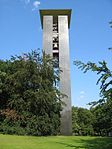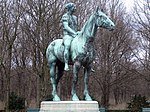Haus der Kulturen der Welt

The Haus der Kulturen der Welt (HKW), in English House of the World's Cultures, in Berlin is Germany's national center for the presentation and discussion of international contemporary arts, with a special focus on non-European cultures and societies. It presents art exhibitions, theater and dance performances, concerts, author readings, films and academic conferences on Visual Art and culture. It is one of the institutions which, due to their national and international standing and the quality of their work, receive funding from the federal government as so-called "lighthouses of culture", from the Federal Minister of State for Culture and the Media as well as from the Federal Foreign Office. As a venue and collaboration partner, HKW has hosted festivals such as the transmediale, curatorial platforms, biennials such as the Berlin Documentary Forum, and mentorship programs such as Forecast. Since 2013, its interdisciplinary elaboration on the Anthropocene discourse has included conferences, exhibitions, and other artistic formats performed together with philosophers, scientists, and arstists, such as Bruno Latour and Hans Joachim Schellnhuber.
Excerpt from the Wikipedia article Haus der Kulturen der Welt (License: CC BY-SA 3.0, Authors, Images).Haus der Kulturen der Welt
John-Foster-Dulles-Allee, Berlin Tiergarten
Geographical coordinates (GPS) Address External links Nearby Places Show on map
Geographical coordinates (GPS)
| Latitude | Longitude |
|---|---|
| N 52.518888888889 ° | E 13.365277777778 ° |
Address
Haus der Kulturen der Welt
John-Foster-Dulles-Allee 10
10557 Berlin, Tiergarten
Germany
Open on Google Maps











